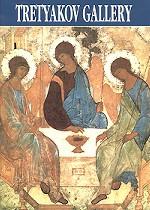

Дата отгрузки на данный момент неизвестна.
Товар закончился у основного поставщика, и, после получения заказа от вас, мы закажем его у других поставщиков. Мы не можем гарантировать выполнение данного заказа, поэтому настоятельно не рекомендуем заказывать данный товар, используя предоплату (банковский перевод и т.п.). Заказ на такой товар действителен в течение 3 недель (если в течение 3 недель товар не придет, заказ будет отменен). Однако, это не означает, что товар нельзя заказать вновь, поскольку в некоторых случаях возможны и более поздние поставки.
Технические характеристики
"Moscow enjoys the reputation of a generous and hospitable city as well as a city of energetic and practical people. The acquaintance with the Russian capital would be incomplete without a visit to the Tretyakov Gallery, the first gallery of national art opened in 1856. Preserved in this treasury of art, together with the works of famous Russian painters and sculptors, is the spirit of its early history and the traditions established by its founder Pavel Tretyakov, a merchant and philanthropist, who was an outstanding art connoisseur yet very modest man.
The gallery which will celebrate its 150th anniversary in 2006 has the vitality of youth and goes on developing through time and in space. When Pavel Tretyakov presented his collection to the city of Moscow in 1892, it numbered about 2,000 paintings, sculptures and graphic works. Today, the gallery holds more than 130,000 items. Its exhibition area has been extended several times. The main building is located in quiet Lavrushinsky Lane in Zamoskvorechye, Moscow`s historical centre, where it used to be in Tretyakov`s lifetime, while the exhibition of 20th-century art is mounted in a new building on Krymsky Val, next to the Central House (Club) of Artists where contemporary artistic life is concentrated. Several branches of the gallery have been opened, these are the Museum Church of St Nicholas in Tolmachi, the house-museum of the painter Pavel Korin, the memorial studio of the sculptor Anna Golubkina, the house-museum of Victor Vasnetsov and the memorial flat of Apollinary Vasnetsov.
The Tretyakov Gallery has always been democratic. Adhering to the best traditions of the past, it was, nevertheless, opened for innovations. Responsive to the love of the public, the gallery made its treasures available to the broad masses of the people. Its policy remains quite the same nowadays. In 1977 Georgy Kostaki`s collection of Russian avant-garde art that had not been rehabilitated yet was donated to the museum, in 2001 the gallery received a collection representing the latest artistic trends and movements and in the spring of 2000 it was the first to open an exposition covering the evolution of 20th-century art which had hardly become history.
As the gallery director, I am proud of the past and present of our remarkable museum and happy to welcome everybody who comes to visit this great and somewhat "sacred" place".
Valentin Rodionov, Director General of the State Tretyakov Gallery